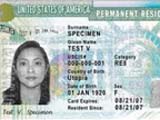
USCIS To Issue Redesigned Green Card
USINFO | 2013-08-15 14:14

Introduction
U.S. Citizenship and Immigration Services (USCIS) announced today (May 11, 2010) that it has redesigned the Permanent Resident Card—commonly known as the “Green Card”—to incorporate several major new security features. Beginning today, USCIS will issue all Green Cards in the new, more secure format.
Questions and Answers
Q. What is a Permanent Resident Card, or “Green Card”?
A. A Green Card is proof of authorization to live and work in the United States on a permanent basis. It also is evidence of registration in accordance with U.S. immigration laws. Newly issued Green Cards are valid for ten years for lawful permanent residents and two years for conditional residents. The permanent resident must renew his or her card each time it expires.
Q. Why did USCIS redesign the Green Card?
A. The Green Card redesign is the latest advance in USCIS’s ongoing efforts to deter immigration fraud. State-of-the-art technology prevents counterfeiting, obstructs tampering, and facilitates quick and accurate authentication of the card. The enhanced features will better serve law enforcement, employers, and immigrants, all of whom look to the Green Card as definitive proof of authorization to live and work in the United States.
Q. What major improvements has USCIS included in the redesigned Green Card?
A. Secure optical media store biometrics for rapid and reliable identification of the card holder. Holographic images, laser engraved fingerprints, and high resolution micro-images make the card nearly impossible to reproduce. Tighter integration of the card design with personalized elements makes it difficult to alter the card if stolen. Radio Frequency Identification (RFID) capability allows Customs and Border Protection officers at ports of entry to read the card from a distance and compare it immediately to file data. Finally, a preprinted return address enables the quick and easy return of a lost card to USCIS.
Q. Is the Permanent Resident Card actually green, as its nickname suggests?
A. After the redesign, the card is now colored green.
Q. Who will receive the redesigned Green Card?
A. Beginning May 11, 2010, USCIS will issue all Green Cards in the new, more secure format. Recipients of the redesigned card will include those newly approved for lawful permanent residency, as well as those who have sought a renewal or replacement card.
Q. What happens to existing Green Cards with the old design?
A. Some existing Green Cards bear an expiration date, and those cards will remain valid until they expire. Holders of those cards will receive the redesigned version when seeking a renewal or replacement.
Other existing Green Cards have no expiration date, and those cards remain valid. USCIS recommends that holders of cards without an expiration date apply to replace their cards with the redesigned version.
The current cost of renewing or replacing a Green Card is $370. Additionally, eligible permanent residents may choose to explore becoming a naturalized U.S. citizen. For more information on eligibility for naturalization, go to www.uscis.gov/citizenship.
Q. What is the USCIS number listed on the front of the card?
A. The USCIS number is the same as the alien registration number, commonly known as “A” number, but without the “A” prefix. The USCIS number or alien registration number is also listed on the back of the redesigned Green Card (i.e., A# 000-000-000).
The “A” number for an individual will not change, but it may be referred to as a “USCIS number,” “alien registration number” or “alien number” interchangeably.
When providing the “A” number to USCIS, either through answering a query or requesting a benefit, please include the prefix “A” in front of the digits.
Q. How does a lawful permanent resident replace a Green Card, if lost or damaged?
A. A lawful permanent resident may seek a replacement card by filing a Form I-90, Application to Replace Permanent Resident Card. The Form I-90 and instructions are available online at http://www.uscis.gov/forms. If outside the United States, a lawful permanent resident should contact the nearest U.S. consulate, USCIS office, or U.S. port of entry before attempting to file a Form I-90.
Share this page



















